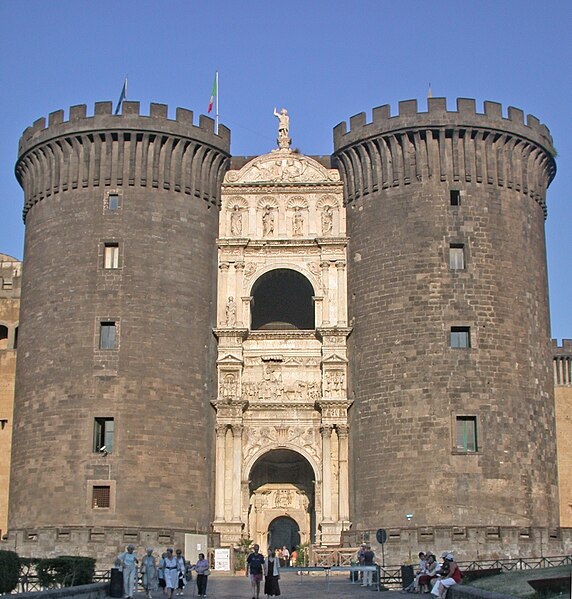Alfonso the Magnanimous was King of Aragon and King of Sicily and the ruler of the Crown of Aragon from 1416 and King of Naples from 1442 until his death. He was involved with struggles to the throne of the Kingdom of Naples with Louis III of Anjou, Joanna II of Naples and their supporters, but ultimately failed and lost Naples in 1424. He recaptured it in 1442 and was crowned king of Naples. He had good relations with his vassal, Stjepan Kosača, and his ally, Skanderbeg, providing assistance in their struggles in the Balkans. He led diplomatic contacts with the Ethiopian Empire and was a prominent political figure of the early Renaissance, being a supporter of literature as well as commissioning several constructions for the Castel Nuovo.
Alfonso as a Knight of the Golden Fleece Miniature from the Southern Netherlands, 1473
Coat of arms in Satyrarum hecatostichon by Francesco Filelfo (1449)
The triumphal arch entrance of Castel Nuovo.
The Crown of Aragon was a composite monarchy ruled by one king, originated by the dynastic union of the Kingdom of Aragon and the County of Barcelona and ended as a consequence of the War of the Spanish Succession. At the height of its power in the 14th and 15th centuries, the Crown of Aragon was a thalassocracy controlling a large portion of present-day eastern Spain, parts of what is now southern France, and a Mediterranean empire which included the Balearic Islands, Sicily, Corsica, Sardinia, Malta, Southern Italy and parts of Greece.
Equestrian heraldic of king Alfonso V of Aragon in the Equestrian armorial of the Golden Fleece 1433–1435. Collection Bibliothèque de l'Arsenal.
Ferdinand II of Aragon on his throne flanked by two shields with the emblem of the Royal Seal of Aragon. Frontispiece of a 1495 edition of Catalan constitutions.
Ferdinand V and Isabella I, King and Queen of Castile and León, and later of Aragon, Majorca, Valencia, and Sicily






